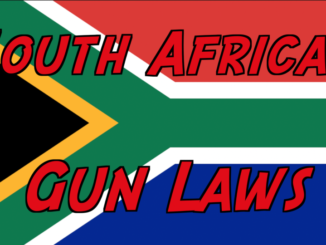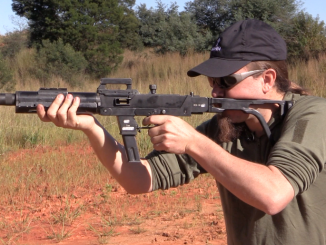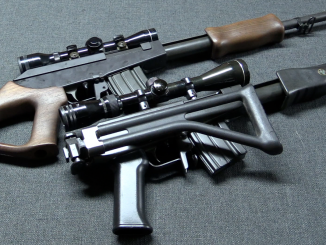When the intercepted Jameson Raid made it clear to the governments of the ZAR (Zuid-Afrikaansche Republiek; South African Republic) and the Orange Free State that war with Britain was imminent, a hasty armaments program was undertaken by both countries. The ZAR went looking for small arms, and wound up buying a tiny number of Krag-Jorgensens, a lot of Steyr Guedes single shot rifles, and about 28,000 modern Mauser bolt action repeaters.
The Boer military system at that time (the Second Anglo-Boer War would run from 1899 to 1902) was based on a universal civilian militia. Every male citizen of the Republic was required to present himself for military service when needed, supplying his own horse, rifle, ammunition, and basic ration supply. These were farming nations, with neither the industrial infrastructure nor the wealth to maintain an arms industry or a standing army. While the kommandos
were sufficient for defending again minor border intrusions, they would be severely stressed by a real war.
Because there was no military standard for arms, the men constituting the ZAR’s army were armed with a mixture of all the rifles types available at that time – really anything that a traveling salesman might have brought to the area in the past couple decades. Sniders, British muskets, Kropatscheks, early Mausers, Vetterlis, and more. When the ZAR government purchased its Mauser rifles and carbines form Loewe/DWM, they were then sold at cost to individual Boers as an opportunity to improve and standardize their arms. Men who could not afford to buy one of the Mausers were loaned one by the government. One interested consequence of this entirely private rifle ownership was that a great many Boer rifles were personalized with carvings of names, battles, and decorations. The usual military taboo on modifying Army property did not apply to a Boer’s personal weapon.
ZAR Mausers have no specific crest nor any mention of the country’s name marked on their stocks or receivers, making them difficult to identify by the casual historical firearms enthusiast. Today we will explain the characteristic features of these scarce artifacts of a mostly-forgotten war.




I was under the impression that the “C” serial-numbered guns were seized by the British then sold to Chile and roll- marked with the Chilean crest.
In the mid 90s I tried to buy the leftovers from a batch of guns that had been Stolen by the British thugs during the second Boer war (if there was any justice in the world, Kitchener, Haig etc, deserved to be hung for the genocide against non combatants, eg “rule .303” the shooting of Afrikaans families and the burning of their farms).
There were Remington Rolling blocks, conventional British service style Martinis, some very nice Westley Richards Martinis with the Francotte style action that allowed the whole action to be removed from the receiver as one assembly, like the small BSA martini actions.
A Krag and Jorgensen in 6.5 x 55
And a mauser 92 (double stack mag, external extractor and the square lower front face of the bolt) with a part octagonal barrel, in 7 x 57.
The guns had been badly stored in Kenya until the 19 60s, or 70s then in a damp part of Britain. There was rust and the stocks had woodworm holes, but there was also Afrikaans carving and personalised touches.
I didn’t manage to strike a deal, neither could a friend who was a full time gun dealer and a really good negotiator.
With hindsight, and having spent a lot of time in S’frica since then. I sometimes think that I should have tried harder.
I have Afrikaans friends who would love to get their hands on rifles like those ones. Parts of their stolen heritage.
I’ve always been partial to the small ring 7mm Mauser carbines. So compact and cute.
Many Canadian vets brought Mausers home as a souvenir. Boer arms were allocated as trophies to Canadian institutions. My local public library had two on display until the 1960s. They still are available if one knows what to look for.
I once read in a contemporary account that since the British Army had prided themselves on their marksmanship since their transition from smoothbores to rifles, they were just a bit put out to discover that the Boer farmers were on the whole better shots than the British soldiers were.
cheers
eon
No surprise as the sights on converted Lee-Metford rifles and the new Lee-Enfield rifles were apparently designed wrong after the ammunition propellant and rifling style changed… the shots generally went way off target even with a soldier’s good alignment of the front post. I suspect that the sights had to be altered to fix that issue in trajectory offset with respect to the predicted bullet path. I could be wrong.
Unlike what military commentators’ opinions are – namely that the “Mauser” won the battles for the Afrikaan farmers (and for the Spanish in Cuba!) it was battelefield tactics and marksmanship that won those battles.
The were no volley firing like the British did, but each farmer picked his individual target – and often aimed for head shots. The First War of Independence which sent the British packing in a hurry must go down as the conflict with the most head shots anywhere because the British soldiers marched with drum beats in open order – AND they all wore white helmets and red jackets.
The derogatory term for the Afrikaans farmers as was employed by the British was “rock spiders” because they were invisible behind the rocks at the ambush points. The British learned that belittling the enemy with words did not diminish the Boers’ superior battlefield tactics.
A very interesting gun culture established itself after the Second War of Independence: Most English speaking descendents own and hunt with the 7×57 and many, many Afrikaans hunters (myself included) hunt with the Lee Enfield No.4 Mk.I / II .303. The Lee Enfield No 4s must be the most effective battle rifles ever built. They are pleasingly accurate and are easy to change into beautiful sporters. My own No. 4 Mk. I built by Savage is still a superb shooter after 78 years and thousands of mostly cordite and fulminate of mercury primed ammunition. Not a visible blemish of corrosion in the bore and a superb one shot killer of elk size game with impressive penetration.
Note – Spanish model 1893 Mausers also have the ‘flat-bottomed’ bolt.
I would refer the readers here to Thomas Pakenham’s history of the Boer War, which asserts some interesting ideas and facts: The Lee-Metford to Lee-Enfield conversion caused the sights to become inaccurate (the spin of the bullet moved the point of impact fifteen inches to the right of line at 1,000 yards!). It was not so much Boer accuracy as Boer volume of fire (stripper clip reloading!) at range that did so much damage to close-order British troops. British shippers, for profit, helped arm the Boers; five million rounds of ammunition were shipped to the Republics through Johannesburg before hostilities opened. Apparently the Boers treated the African population even worse than the British did, and thus the British gained African allies throughout the war. Both sides’ use of artillery was quite creative: the Boers obtained some 37-mm Maxim pom-poms and a couple of Krupp siege guns; one bunch of besieged Brits revived an old black-powder muzzle-loader that had been relegated to use as a memorial monument.
“Boer volume of fire”
Though, if I am not mistaken, British forces deployed globally more machine guns that Boer, but often without tactic best suited to show all advantages of that weapon, most often they were used defensively, for more see: https://www.bwm.org.au/mgs.php
” Both sides’ use of artillery was quite creative”
According http://www.labuschagne.info/big-guns.htm British forces also used 4.7″ guns from HMS Terrible adapted for land use (see 2nd photo from top)
My grandfather fought on the Boer side (for the simple reason that he was a Boer and thought it his duty to join the fight, although he was a citizen of the then British Cape Colony). I must express my sincere appreciation that you thought about us and our Boere Mausers, which has a holy status in our hearts , just one minor correction: We do not consider ourselves as “Dutch” as we are descendants of German, French, Dutch and even English and Portoguese settlers. Thus a merry mixture of the best nations in Europe.
LDC wrote:
” It was not so much Boer accuracy as Boer volume of fire (stripper clip reloading!) at range that did so much damage to close-order British troops.”
Indeed it was the accurate shooting of the Boer farmers (“boer” is the Afrikaans word for “farmer”) and not volume of fire. Ammunition availability was forever a problem and “make your shot count” was the credo. Volley firing was never part of battle tactic. That and the Firs War of independence were the wars with the most head shots in the history of the world. Winston Churchill who was a war correspondent and taken prisoner by the Boers wrote about the ability of the Boer snipers to do head shot with their 7x57s at 600 yards.
Due to regular ammunition shortages Boer commandos often fought their battles with Lee Metfords taken from the Brit supply trains they had sabotaged and of course from the battle grounds. They still shot these rifles better than the British soldiers did. Why? Because each Boer picked his own target, judged his own distance and set his own sights and there was no “Ready! Aim! Fire” command.
The change to the sights due to the new lighter weight (174 gr) ammunition only came about long after that war.
Turkish M93s also have flat bottomed bolts.
Ian McCollum’s summary of the cause of the war and events that lead up to the war is really excellent. Most the Boers could snap shoot really well. Even today those people in the Karoo are masters of this skill. The South African army in the seventies and eighties had a standard course for snap shooting, called “Boslaan”. So even at short distance the Boers could out-shoot the Brits. This is conformed by Denys Reitz in his excllent book, “Commando”.
Ian’s record and research during his visit to South Africa was good and is appreciated. He only erred in one respect and that was by calling the Boers “Dutch” farmers. The Dutch were a distinct minority amongst the Boers. The majority were of French Huguenot descendancy with maybe equal German and Dutch amongst them.
I know that the Mausers turned back by the Brits were at least partially sold subsequently to Chile as I am holding a Boer pattern DWM mauser that is 50 serial number places earlier than the one in this video. It has a beautiful, factory engraved crest of Chile on it.
So at least some made it back to DWM and were then sold to Chile.